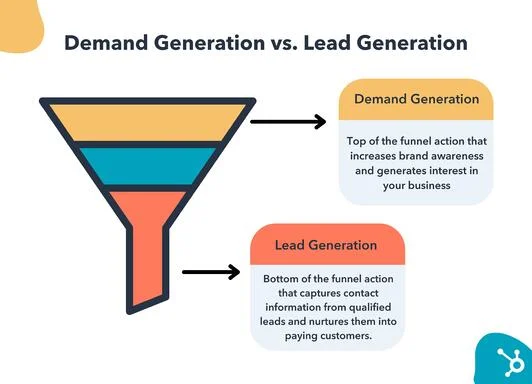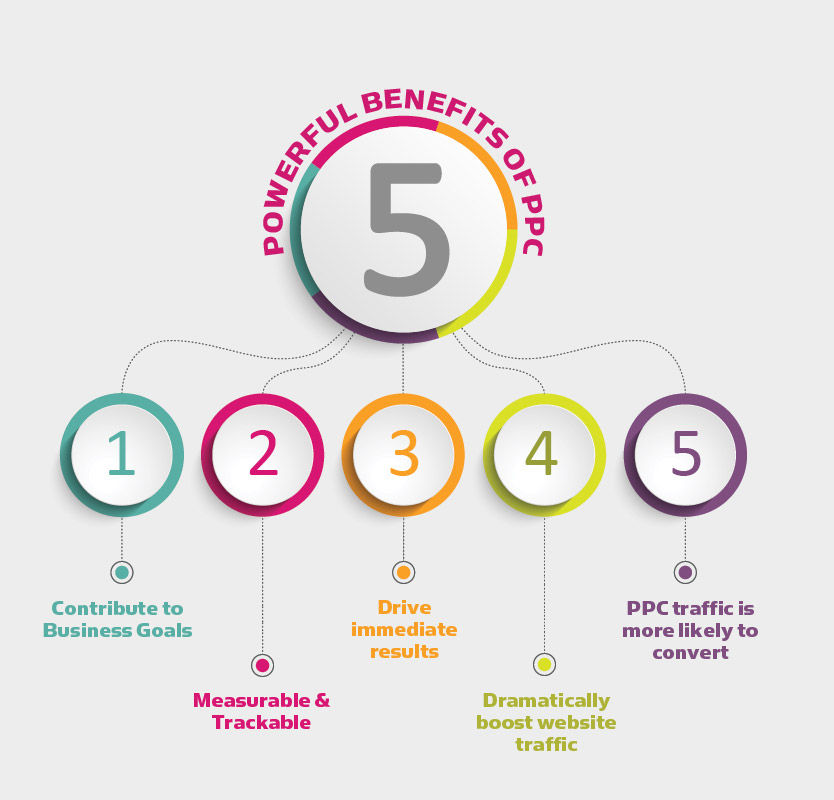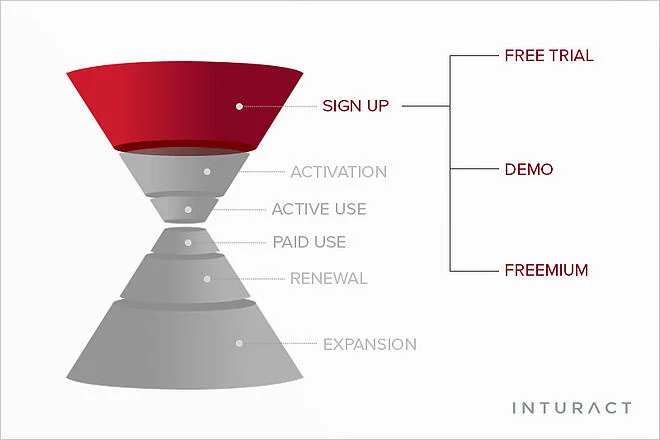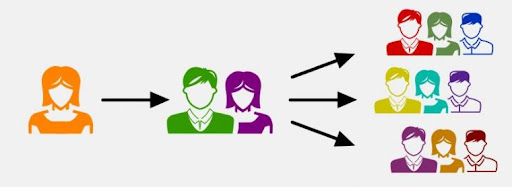SaaS Demand Generation Explained
Generating leads and traffic is the biggest challenge for 61% of marketers. The reason for that is they don’t use the correct strategies to get potential customers or existing customers interested in their new features or products, and this is exactly where demand generation comes into play.
If you’re looking for a way to get more leads to your sales team or get your old customers excited about your services again, keep reading.
What is SaaS Demand Generation?
Demand generation is getting potential customers or existing customers interested in your services and products. In its essence, SaaS demand generation is the same: its goal is to create demand from customers that fit your Ideal Customer Profile.
The demand generation techniques and processes can be better understood by looking at the SaaS marketing funnel. The SaaS marketing funnel tells you about each stage of a customer’s journey. You need the first to enter this funnel to get people interested in your product. Demand is generated at its top, where brand awareness is created.
SaaS companies must have a good demand generation strategy as their sales heavily rely on getting people aware and interested in the product they sell. Below are the steps you should take and the strategies you should follow to create demand for your brand.
All SaaS companies are somehow involved in the demand generation process, either with a passive or aggressive attitude. It may be appropriate for you to take advantage of popular demand generation channels to get the required efficiency from SaaS demand generation. Thus, you can earn new qualified leads and bring your marketing qualified leads (MQLs) closer to your product.
Demand Generation vs. Lead Generation
Demand generation is different from lead generation: Lead generation is getting the information of those interested so that you can interact with them until they are ready to purchase. Demand generation comes before this step.
Lead generation and demand generation differ in how the content will be used. The purpose of creating content in demand generation is to gain the trust of potential customers by creating product awareness. In lead generation, content is created to turn an audience into leads by communicating directly.
For a good lead generation process to take place, demand generation must also take place properly. With the successful execution of demand generation marketing, the number of qualified leads targeted by lead generation will increase.
In SaaS companies, the two processes are closely related and help bring qualified marketing leads to your company. While SaaS demand generation aims to grow, the main focus of SaaS lead generation is to convert. For lead generation to take place and to connect new customers to your company, you need to gain the attention of the masses through popular SaaS demand generation channels.
Let me explain the connection between the two processes with an example. One of the most popular demand generation channels in SaaS businesses is blogging. Let’s say you want to attract customers for your SaaS company with your blogs. After you perform your SaaS company’s demand generation, you decide to convert your marketing qualified leads into customers with the CTAs you place on your website. Lead generation aims to convert qualified leads to customers by obtaining contact information such as e-mails with CTAs.

Important SaaS Demand Generation Strategies
SaaS demand generation aims to increase the number of customers affected by your company. With SaaS demand generation, you can increase your product awareness and generate more qualified leads. Qualified leads will increase your SaaS company’s revenue.
Successful SaaS demand generation and enjoying its benefits depends on properly using popular demand generation channels and a good strategic plan. Developing the right strategies can reduce customer acquisition costs and make your company’s demand generation more efficient. In the continuation of the article, you can learn about the appropriate demand generation methods for your company and how you can achieve them.
Inbound marketing
Inbound marketing is the must-have marketing strategy for all SaaS companies, and inbound marketing is about attracting customers to your brand by having a strong presence on various platforms and establishing a good name and reputation in your industry. The most important inbound marketing techniques include:
- Content Marketing
You must create content consistently to be visible on the internet and seen as a leader in the industry. People who are searching for a service similar to yours have specific questions. Your content should address their inquiries, and if you’re able to be the first brand to answer them, they’ll remember you. That is why 70% of marketers are highly involved in content marketing.
There’s a whole step-by-step guide to content marketing on our blog, but to summarize quickly, you have to:
- Define your ideal customer profile to locate the needs you’ll address,
- Analyze your competition to make sure you don’t miss out on important subjects or keywords,
- After creating a timeline for your content, you should find the right distribution channels,
- And measure the performance of your content and make adjustments according to the key content marketing metrics.
Once you have followed these steps, your content will be easily available to the right people. This creates band awareness, pulling people to the top of your funnel.
2. Landing Pages
There are three likely scenarios when it comes to landing pages: the visitor may just not go on your page, skim/go through the page, or leave as soon as they enter. If your landing pages are created to show your features’ exciting and interesting sides or in a way that catches the eye, then you’ll be able to get searchers to interact with them. And if your landing page is created specifically for your buyer personas with their needs and pain points in mind, you’ll be able to get them to read at least the headline–and most of the time, that’s enough. 90% of visitors who read your headline will also read your call-to-action (CTA).
This means that an effective landing page, by just attracting a reader’s attention to its headline, can leave an impression on the visitor, getting them interested in your offers.
3. Email Marketing
Email marketing is effective for both demand and lead generation. It’s quite intuitive: when you address the reader directly by sending out personalized emails, and when you have clear headlines and CTAs, the receiver clicks on whatever link you’ve sent them because they’re intrigued.
The hard part is perfecting your email marketing strategy so that your emails do everything I’ve mentioned above. In a previous article, I have compiled a list of engaging emails from SaaS companies and why they’re effective in getting you some inspiration for your emails.
SEO
Another aspect that defines the success of your demand generation strategy is SEO. 94% of organizations investing heavily in demand generation agree or strongly agree that their online presence and organic reach are vital to their demand generation’s success. It’s true: your content and site should be optimized so that it’s impossible to miss your brand’s name when doing a search related to your niche.
So how can you make sure that your sites are preferred by search engines? By following the correct SEO methods. There are a few benchmarks to keep track of:
- Make sure your website is free of crawl errors or errors in general. Decrease response time and make sure that your site is user-friendly.
- Create relevant content: this is not the same as creating engaging content for your customers, this time, you’re creating content that’ll be favored by the search engine, and that’s done by targeting specific keywords and subjects.
- Create in-depth and up-to-date posts. Both search engines and visitors prefer content that is up-to-date and detailed.
- Make use of backlinking. Ensure that your content is worth mentioning, and when you get mentioned on a guest site, check to see if your site is linked. Backlinks are crucial to SEO.
But how do you make sure that these methods are working? Using the right SEO tool is vital. A good SEO tool will tell you how much traffic you’re getting, where it is from, and how you rank your page speed insights and backlinks. You’ll know which step to work on using your SEO reports.
Once you’ve worked on SEO, your posts and pages will be the first to appear on a Google search, leading to brand awareness and more clicks.

PPC traffic
PPC ads are digital ads that run on popular search engines, social media, or e-commerce platforms to drive high-quality traffic to your site. They’re so effective that they can improve brand awareness by 140%. By catching the eye of a scroller on Instagram, you can get them to take a glimpse at your ad and acknowledge your brand’s name. This is a big win for demand generation.
So how can you ensure that your ads perform to their fullest potential?
- Don’t have the same aim for all of your PPC ads.
Regarding demand generation specifically, it’s important to understand that the first step isn’t to make sales. A big portion of your ads should focus on driving traffic or creating brand awareness rather than generating leads.
- Make them targeted.
This applies especially to Facebook and Google Ads. It’s harder to reach the right people on Facebook, so you want to direct your ads to a specific list of accounts that fit in with your buyer personas. For Google Ads, you’re able to show your ads to people who have been searching for terms that would indicate an inclination towards being interested in your product. Make use of this Custom Intent segment. Other platforms, such as LinkedIn, have various targeting options, and you should be selecting the option with your specific objective in mind.
- Make use of negative keywords.
While creating a PPC ad, you tell Google (or whichever platform you use) what your ad is about. But it’s as important, if not more, to tell Google what your ad isn’t about so that it drives traffic from the right sources. For instance, if you’re selling second-hand controlled toy cars, you must ensure that Google doesn’t show your ad to people searching for second-hand cars. This simple example applies to SaaS companies because services are interconnected contextually, but what they’re offering and who they’re offering to differs significantly.
- Check all the metrics while measuring their performance.
The conversion rate is important, but it shouldn’t be the sole metric you’re tracking. Some ads will result in sales, though not all of them. But that doesn’t mean that your ads are necessarily unsuccessful. The impression rate, the click-through rate, and demographic scores are the metrics that show you whether your ads are driving traffic or not.

Demo Request / Free Trial
Once you’ve established your brand position and heard your name, it’s time to get people to consider your product. However, it’s much harder for a visitor to consider paying for your service if they’re not sure about it. The best way to get them interested in your product is to let them use it for a while, which is what free trials are for.
There are a few reasons why free trials are so effective in generating high-quality demand:
- They show your potential customers that your brand is not making up all those features you’ve discussed in your PPC ads or landing pages: establishing trust makes you more likely to build long-term sales relationships.
- When people start using free trials, they begin to integrate your service into their business routine. If your service fits their needs, they’re likely to become accustomed to your tool and may even start depending on it.
- People can compare your product with others, and even if they don’t directly buy it, you’ll remain in their minds as a possibility.
However, offering free trials and demo requests aren’t always the most profitable. If not planned according to your budget, these trials may cost more than they bring back. Make sure the free trials are offered for a limited time and choose how long that will be. If the trial is too short, users won’t make a habit of using it and won’t need to buy your product later. If it’s too long, the cost will increase accordingly, burdening your profit.

Customer Marketing
You may think customer marketing is about getting new people to notice your brand. However, this technique is also about re-engaging your old customers. It’s not enough to only get them interested in your product before making a sale: as a SaaS company, you want to keep their subscriptions. Thus, you need to generate demand again and again from existing customers. Customer marketing makes sure that your base feels important, which keeps them connected with your brand. However, this is not the only place where customer marketing is used. This marketing strategy is also used to generate “word of mouth,” which heavily influences buying decisions according to 91% of B2B buyers. The reason is simple: you trust a brand more if someone you know has trusted them.
As the name suggests, this marketing technique focuses on existing customers instead of prospects. Besides improving your relationships with your customer base to keep them interested, customer marketing is also a great way to create brand advocates who will generate demand for you. If you show your customers that you care about their needs and opinions, they’ll trust you and tell others that they trust you, which is exactly what we want.
There’s a more detailed customer marketing guide on our blog. But the most fundamental customer marketing strategies can be listed as:
- Give them private treatment as soon as they become your customer: these are what welcome emails are for.
- Hosting customer events: these can be as simple as monthly meetings with customers to get their feedback or a webinar to educate them on a specific usage of your tool.
- Highlighting customer success stories: if your product helped a customer to a great extent, give them the mic and let them tell others how.
- Being open to feedback: this means generating online reviews, using surveys, and improving according to your customers’ wants and needs. Understand why churn is happening and make adjustments (Hockeystack is here to help with churn optimization!)
- Rewarding your customer base: giveaways, discounts, or freebies are always nice to show your customers you care.
In the end, you know your customer base the best (hopefully.) Don’t forget to cater to them because you’ve already sold your product.
Referrals
In the headline below, I talked about the importance of word of mouth. The term “word of mouth” can be summarized in a more formal word: referrals. Customer marketing is a great way to generate referrals organically, and the advice above increases your chances of creating organic referrals. However, organic referrals are often not enough on their own. You need to give customers an incentive (other than I love this product so much I felt the need to talk about it.)
These incentives are referral programs, and they’re especially effective for SaaS. Since customers and services operate online for SaaS, sending out referral links via email or social media makes sense. However, as with every other marketing technique, referral programs have a few points you should be careful about.
- Make your programs simple. Tell your customers that they’ll get a 10% discount code if they send the link to their friend, and if their friend clicks on the link, send them the discount code. Don’t have them dig through your website to find the referral link; make it accessible. Don’t have them fill out long forms, have as few steps as possible. This way, people won’t be discouraged from joining your referral campaign, and you’ll reach more people.
- Ask at an appropriate time. You should’ve cared for your customer and provided good customer service and a working product before asking them to refer to a colleague.
- Know what motivates your customers. Maybe a discount code isn’t what they need, but what they want is a mention on your blog to get some attention to their business. You already know why your customer bought your service, so you have an idea about their business goals and incentives. Create referral campaigns with incentives that serve their goals.
- Make the process transparent. Don’t tell your customers that you’ll mention their brand on a post and forget all about it, just to dedicate a post to them two months later. Similarly, don’t make their discount code hardly accessible. These will make your brand less trustable and decrease the possibility of getting referrals in the long run.
Once you’ve started your referral campaign, measure its success using the right tools. Some software brands are Tapfiliate and Affise, which allow you to create, track, and optimize referral programs.
Conclusion
In its essence, demand generation is all about pulling people into your sales funnel and to the awareness stage. You get your name in their minds and build a good reputation. The points above thus have common effects: they all build trust, accustom people to your brand name, and get people interested by word of mouth.
Before trying to optimize the lower stages of your marketing funnel, which is a mistake most businesses make, be sure to establish and use a good demand generation strategy. This way, generating long-term leads and advocates for your brand will be much easier.
FAQ
Demand generation tactics include inbound marketing, SEO, and PPC ads to drive traffic, free trial/demo requests, customer marketing, and referrals.
Demand gen software is a tool that’s used to engage with prospects until they become long-term customers. This tool helps promote products and increase consumer interest in services.
Demand generation is essential for engaging prospects and re-engaging existing customers.






